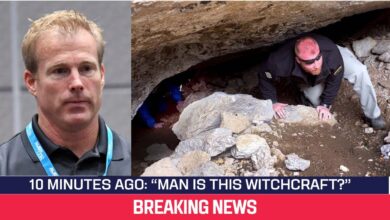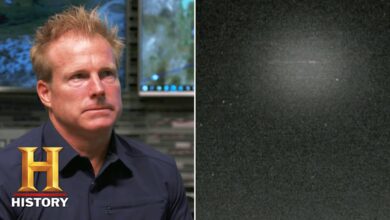Skinwalker Ranch Officials Finds a PORTAL!
Skinwalker Ranch Officials Finds a PORTAL!

Episode 11 of The Secret of Skinwalker Ranch season 6, Hard to Handle, may well be one of the most astonishing and unsettling installments the series has ever aired. What begins as a seemingly straightforward materials analysis soon escalates into a jaw-dropping breakthrough as the team examines a strange ceramic-like substance retrieved from deep within the mesa—a location long associated with intense electromagnetic anomalies, unexplained sightings, and structural mysteries hidden underground.
This fragment isn’t just unusual. It appears to defy conventional understanding of material science. Its composition and resilience raise profound questions about whether it was formed naturally under conditions unknown to modern geology or engineered with technology far beyond anything currently available.
As the investigation unfolds, the stakes become clear. The History Channel’s preview hinted that the team would face a difficult decision about their next move. And by the episode’s end, that choice looms large—whether to push deeper into the mesa in pursuit of more answers or to pull back in the face of risks they still can’t fully measure. What they choose could alter not only the direction of the season, but possibly the entire investigation into Skinwalker Ranch.
After witnessing what unfolds in this episode, it’s easy to understand why it’s being hailed as one of the most pivotal moments in the ranch’s investigation. The latest lab results don’t merely point toward advanced technology—they hint at the possibility of something alive, adaptive, and perhaps even intelligent operating deep within the mesa.
The episode opens with a drilling team and scientists gathered around the most recent spoils from the deep bore operation. These aren’t just chunks of rock. They’re potential clues to a mystery that has resisted explanation for decades. The mood is tense as the team inspects the remains of one of the drill teeth, a component forged from alloys specifically engineered to endure extreme pressure, intense friction, and some of the hardest rock formations on Earth.
Yet, this drill tooth has been worn down almost to nothing, as though it had encountered not just resistance, but a force actively working against it. The real shock comes when they attempt to examine the bore hole itself. Instead of an open shaft leading deeper into the mesa, they find it inexplicably sealed, as if the surrounding material had somehow melted and fused together to create a solid wall.
In ordinary geology or engineering, there’s simply no mechanism for a tunnel to heal itself under such conditions—unless it had been subjected to tremendous localized heat, or, more disturbingly, was interacting with a self-repairing material designed to close any breach. For seasoned investigators like Dr. Travis Taylor, Thomas Winterton, and the rest of the crew, this discovery is more than baffling. It’s alarming.
The implications are vast. If the mesa contains engineered structures capable of repairing themselves, then the team may not be drilling into inert rock at all, but into something that is reacting—perhaps even defending itself—against their intrusion. The question that hangs heavy over the group is no longer just what is inside the mesa, but who or what doesn’t want us to find it.
From the drilling spoils, the team recovers several fragments of what, at first glance, resembles ceramic or high-grade composite. It’s dense, finely textured, and unlike any geological sample they’ve pulled from the mesa before. But the real surprise comes under the microscope. Magnified, the material’s surface reveals a highly organized, almost honeycomb-like architecture—a repeating network of tiny, sharply defined holes arranged with uncanny precision, as if engineered rather than formed by natural processes.
Then comes the moment that stops the room cold. As the electron beam from the scanning microscope sweeps across the surface, something begins to happen—something no one is prepared for. The holes slowly constrict. Fractures begin to soften and disappear. Within moments, the damaged surface is smooth once more. The material is quite literally healing itself before their eyes, and the process is happening fast enough to watch in real time.
There’s no sign of chemical coating, no residue, no added material—only the uncanny impression that the substance remembers its original structure and is restoring it. For modern science, this borders on science fiction. The closest parallels—self-healing polymers, shape memory alloys—are still in the early stages of development and require controlled triggers like heat, moisture, or electrical currents. None of them operate with this kind of speed, precision, or autonomy.
The discovery throws the team into a heated debate. If this is purely technological, it suggests an advanced engineering capability far beyond anything currently available on Earth. But there’s another, even more unsettling, possibility: What if this material isn’t just like something alive, but is alive? Could it be a hybrid of technology and biology, or even a form of bio-engineered organism designed to repair and maintain a structure buried within the mesa?
The possibility of a hybrid material—something engineered yet capable of biological-style repair—sends a palpable chill through the group. If this strange ceramic-like substance is only a fragment of a much larger construct hidden within the mesa, its function could be far more intricate and intentional than anyone has dared to speculate. It might not simply be a passive structural component; it could be part of an active defense system designed to seal tunnels, shield the interior from intrusion, or even adaptively counter human exploration.
In cutting-edge aerospace engineering, self-repairing materials are envisioned as the next revolution for spacecraft, enabling them to automatically mend micrometeoroid impacts and other damage in the unforgiving vacuum of space. But here, buried deep beneath the Utah desert, the team is confronted with a material that appears to have been performing such repairs flawlessly—perhaps for hundreds, if not thousands, of years.
The unnerving part is the timing. The bore hole welds sealing itself shut and the sample’s self-healing behavior seemed too coincidental to ignore. For some on the team, this raises a staggering possibility: The mesa isn’t just a geological formation with strange anomalies—it might be responding to their actions.
If the so-called bubble anomaly they’ve been detecting is not merely a passive energy field, but an integral part of an active system, then they may have been probing the outer defenses of something deliberately concealed. In that light, the ceramic material takes on an entirely new significance. It could be a literal shell—a high-tech, self-repairing outer skin engineered to safeguard whatever lies at the mesa’s core.
And if that’s true, then every drill bit, every radar pulse, every attempt to breach it may be provoking a reaction from whatever intelligence—human or otherwise—placed it there. The fact that the bore hole sealed itself almost immediately after drilling makes this theory not only more plausible, but far more unsettling. It ties directly into patterns seen in earlier seasons where instruments failed without explanation, GPS units spun wildly off course, and drilling equipment broke down mysteriously when approaching certain depths.
If the mesa is indeed acting in a reactive, possibly intelligent manner, then the investigation has entered an entirely new level of risk and significance. Longtime viewers will recall that past excavations revealed metallic fragments embedded within the mesa that matched aerospace-grade alloys—the very kind used by NASA and SpaceX for re-entry shielding. Now, with the discovery of a self-healing ceramic-like substance, the evidence strengthens a hypothesis that has lingered since the show’s earliest days: An ancient or non-human craft, or at the very least, a technologically advanced structure, could be buried beneath the mesa.
Adding to the intrigue, earlier episodes of season 6 documented the team repeatedly encountering invisible walls in the air, sudden bursts of electromagnetic energy, bizarre radar returns that suggested objects where none should exist, and even a strange green gelatinous residue—possibly the byproduct of intense high-energy events or ancient subterranean fires.
Taken together, these anomalies point to a complex, layered system beneath the mesa, potentially composed of multiple exotic materials working together—metal alloys, self-healing ceramics, and perhaps even other substances not yet identified—forming a protective shell unlike anything known on Earth.
By the episode’s tense conclusion, the team is forced to confront a serious dilemma: Do they push forward aggressively with deeper, more invasive drilling, risking damage to or the activation of whatever lies beneath? Or do they slow down, gather more data, and develop specialized techniques that might allow them to interact with this mysterious technology without triggering a catastrophic reaction?
It’s a choice that could shape not just the rest of the season, but the entire trajectory of the Skinwalker Ranch investigation. The decision facing the team isn’t just about preserving the integrity of the material—it’s about ensuring their own safety. If this self-healing ceramic is part of an intelligent defense system, pushing the drilling any further could provoke an unpredictable and potentially dangerous response.
In previous seasons, the ranch has already shown its capacity for harm—unexplained injuries, sudden radiation burns, and the outright destruction of expensive equipment. Now, with concrete evidence of reactive, self-repairing technology, the possibility that the mesa could respond in far more aggressive ways than ever before is impossible to ignore.
While much of the episode is grounded in meticulous lab testing, high-resolution microscopy, and drilling footage, there’s a persistent undercurrent of deep, almost primal mystery. Viewers are left to grapple with the same questions haunting the team: Is this material the work of ancient visitors, an artifact of an interdimensional construct, or even a fragment of a living machine?
Some of the more speculative theories gaining traction point toward the idea of space gates or dimensional bridges—portals built and maintained by advanced civilizations, shielded by adaptive barriers that repair themselves as part of their security protocols. Others take a different angle, suggesting that the mesa might conceal the wreckage of a centuries-old craft, one that has been slowly, methodically repairing itself over time.
This could explain the scattered aerospace-grade fragments uncovered in earlier digs, the anomalous energy readings, and the invisible walls encountered in the airspace above. Whatever the truth, Hard to Handle leaves no doubt: the team is now operating at the razor’s edge between groundbreaking discovery and unforeseen danger.
And the mesa may be far more than just a silent witness to history. If either of the leading scenarios is true, then Hard to Handle isn’t just another entry in the Skinwalker Ranch saga—it could mark the beginning of confirming one of the most extraordinary discoveries in human history.
Episode 11 delivers something vanishingly rare in paranormal investigation television: a tangible physical artifact that doesn’t merely suggest something unusual, but openly demonstrates behavior that modern science cannot fully explain. The sight of a fractured surface knitting itself back together in real time under direct observation is the kind of moment that forces a paradigm shift.
For the team, it’s more than a lab curiosity. It’s a revelation that could redefine their entire mission at Skinwalker Ranch. The self-healing ceramic raises questions that cut to the core of the mystery: Who created it? How ancient is it? Is it acting as a shield to protect something or someone deep within the mesa? And perhaps most unsettling of all, is it somehow aware of the team’s presence and their attempts to penetrate it?
With only a few episodes left in season 6, the stakes have never been higher. The team must decide whether to confront the mesa head-on, risking the possibility of activating or damaging whatever lies within, or to step back, develop new strategies, and approach the mystery more cautiously before triggering a response they can’t control.
One thing is certain: Hard to Handle has altered the trajectory of the entire investigation. Whatever happens next could finally drag the ranch’s deepest secrets into the light—or ensure they remain buried forever. And if the mesa is indeed harboring self-repairing materials, it may no longer be appropriate to think of it as a static geological formation at all, but as something far more complex and possibly alive.
It could very well be a biomechanical fortress, a structure that blurs the line between living organism and engineered machine. In certain fringe physics and speculative aerospace concepts, self-repairing materials are often associated with systems capable of manipulating energy on a grand scale, including generating cloaking fields, regenerating damaged structures, and maintaining stability under extreme conditions.
This could explain why previous aerial radar sweeps, LIDAR scans, and laser mapping of the mesa have revealed strange bubbles of distortion, as if the formation is shrouded behind an adaptive energy curtain, deliberately masking its true contours from observation.
In that context, the self-healing ceramic might not be just a random artifact, but a critical component in a much larger system—perhaps even a space gate mechanism. Such an engineered device, if real, could be capable of opening corridors between dimensions or bridging unfathomable distances across the cosmos.
If a gate exists within the mesa, then this material’s role may be to reinforce and stabilize the structure’s outer shell, allowing it to endure the colossal stresses of dimensional transit or high-energy field manipulation. That would also make its ability to instantly repair itself not just a defensive measure but an operational necessity, ensuring the integrity of the gateway under conditions that would obliterate conventional matter.
What makes this even more compelling is the way it resonates with cultural history. Indigenous Ute and Navajo oral traditions have long warned of sacred or forbidden doorways within the mesa—portals to other worlds guarded by powerful forces that punish trespassers. These ancient accounts, once regarded as purely mythic, now seem eerily aligned with the technological mystery emerging from the team’s latest discoveries.
The past and present may be converging, hinting that the mesa’s secrets are both older and stranger than anyone dared to believe. Multiple episodes have documented how specific zones on the ranch produce anomalies that bend radar beams, scramble GPS signals, and cause drones to slam into invisible walls mid-flight. These may not be random electromagnetic glitches at all, but rather deliberate energy barriers—invisible force fields operating as part of a layered defense network.
If the self-healing ceramic is a component of that system, then these force fields could serve as the first line of active protection, working in tandem with the regenerative shell to ensure that any breach is sealed and repelled in real time.
Skinwalker Ranch folklore is filled with tales of wolf-like beasts, towering shadow figures, and flying creatures appearing in areas of intense activity. While many dismiss these as superstition or misidentification, some researchers have proposed a more startling possibility: that these beings are not random apparitions, but biological security systems genetically engineered or otherwise linked to the mesa’s concealed infrastructure.
In this framework, the self-healing ceramic would function as the outer skin of a physical gateway, while these creatures operate as mobile patrol units—ensuring that the structure remains hidden and unapproachable for centuries, if not millennia.
Adding another layer of intrigue, this episode features the unnerving appearance of a low-flying aircraft near the ranch, coupled with the suspicion that the team’s activities are being covertly recorded. Whether the surveillance points to private interests, government agencies, or another unknown group, it raises a chilling question: If the mesa’s secrets are being protected, is it only by whatever intelligence may be built into the structure, or are human hands also working to keep its true nature from being revealed?
If the U.S. government, private defense contractors, or even foreign intelligence agencies have long been aware of what lies beneath the mesa, then the team’s drilling efforts may not just be pushing into unknown territory—they could be stepping directly into the heart of a centuries-old cover-up.
In that light, the self-healing ceramic may not be wholly alien in origin. It could represent the culmination of a covert, Earth-based program—one aimed at reverse-engineering recovered non-human technology and integrating it into a controlled system.
If the mesa’s core truly houses a dimensional device, then the ceramic’s regenerative capability might serve more than just structural repair. It could also act as a stabilizer for distortions in space-time. In such a role, it wouldn’t merely heal physical damage, but ensure that the extreme stresses of dimensional transitions or the instability of a portal interface never cause catastrophic collapse.
This theory dovetails with one of Skinwalker Ranch’s most unsettling patterns: repeated accounts of time anomalies. Over the years, multiple witnesses—from ranch workers to visiting investigators—have reported losing chunks of time, experiencing sudden temporal disorientation, or even witnessing events occur out of logical sequence.
If the ceramic is part of a mechanism designed to maintain both spatial and temporal stability, then these anomalies may not be malfunctions at all, but side effects of a system still operating—at least partially—as intended.
This points to a staggering possibility: that the technology within the mesa may function not only across space but also through time, repairing more than just physical damage. It could be actively preventing temporal collapse, like a cosmic maintenance system patching rips in the very fabric of reality.
In that context, each new piece of evidence makes it harder to view the mesa as merely a geological form. It begins to resemble a living, adaptive gateway—a construct guarded by invisible energy fields, patrolled by enigmatic creatures, and under the watchful surveillance of both human and possibly non-human intelligence.
If the team dares to push further, they may not simply be uncovering the past—they could be crossing into it, or into an entirely different realm where the normal flow of time and space no longer applies.
In that sense, Hard to Handle may be more than just a turning point in the investigation. It could be the final warning before the mesa itself decides the threshold has been crossed and responds in a way that no one can predict or control.








